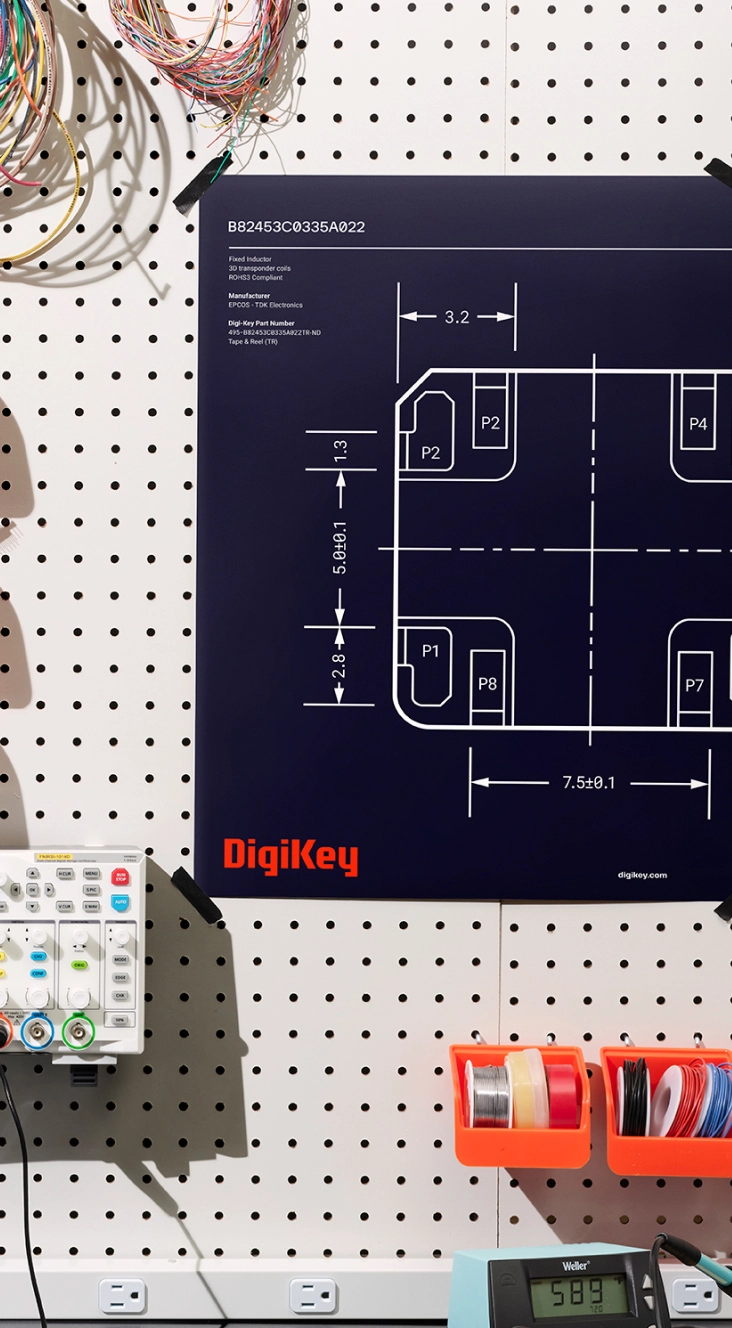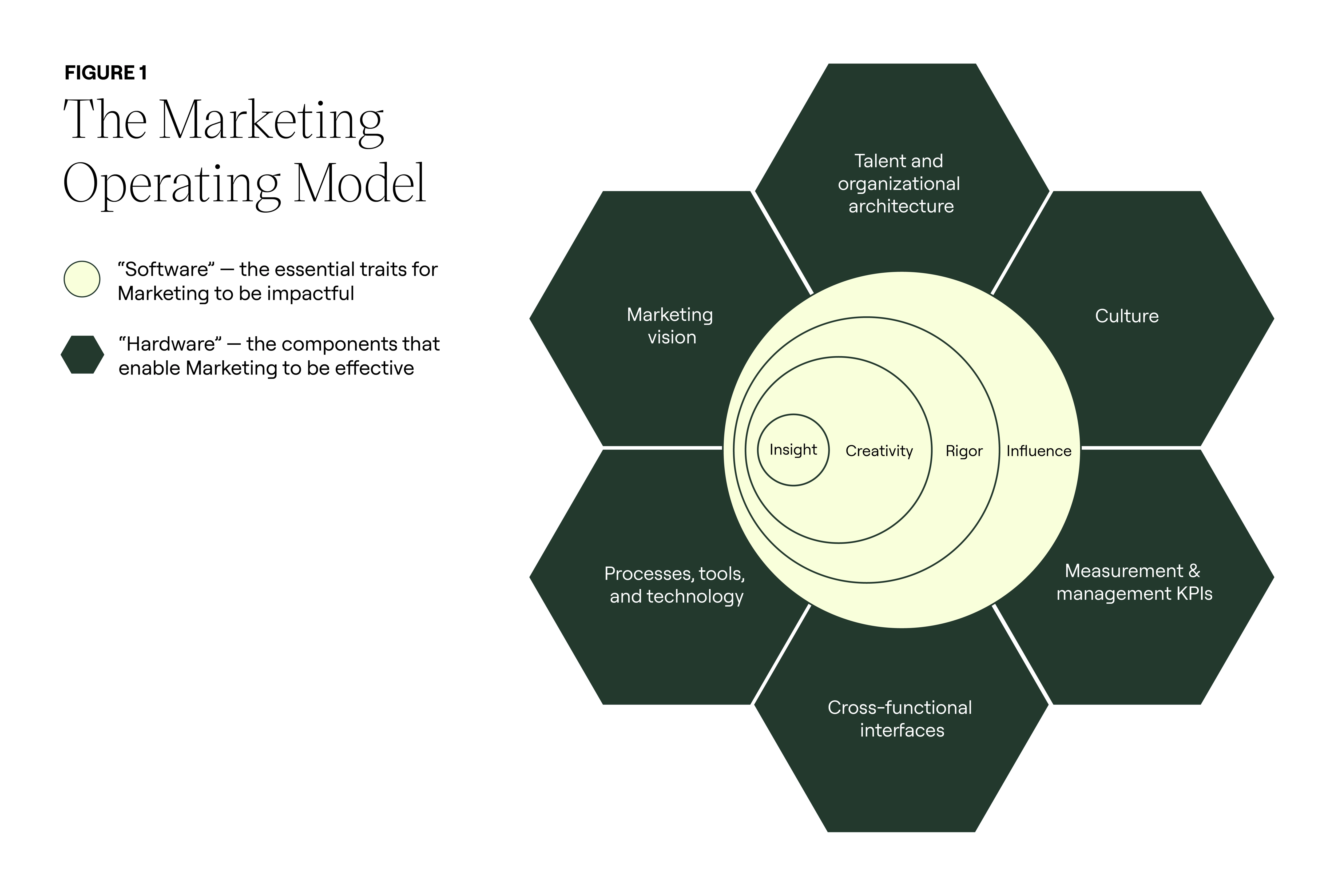April 9, 2024
Three steps to enhancing your Marketing Operating Model

When was the last time your CFO volunteered to give marketing greater investment?
We’re guessing rarely, if ever. For many, marketing is seen as a cost center. The function where flamboyant personalities head off to Cannes and celebrate creative achievement, while the rest of the organization drives measurable impact for the business. That’s why only 32% of CEOs said that they trust marketing to grow their business. Meanwhile, the pace of change (hello, Generative AI!) is disrupting the very meaning of creativity and its application. That’s why we haven’t yet met a CMO who isn’t looking at opportunities to both strengthen their operation and demonstrate value.
A strong Marketing Operating Model (MoM) is essential for a CMO to be successful, but few are clear about what that means or how they’re built. A common starting point is to ask for benchmarks—looking at peers to compare roles, headcounts, and capabilities.
The problem? That approach is wrong.
Here’s why: While benchmarking has a role, every company operates in a unique context that a simple comparison analysis can’t accommodate. In addition, this approach is cost- versus opportunity-focused, so the conversation centers on minimizing headcount versus increasing productivity.
Our approach to building impactful marketing operating models has three key steps:
01 | Start with your vision
02 | Design your software
03 | Build your hardware
Let’s unpack each of these.
Start with a vision for Marketing
First things first: We always start by defining a vision for marketing’s role in the organization. Everything else should flow from that definition. Have you written down your vision of the role you want marketing to play? Is that vision shared by your team, by the C-suite?
When a CMO joined a global bank as Head of Enterprise Marketing, we started our project with a simple question: What was her ambition for enterprise marketing? She told us she wanted it to help facilitate a consistent client experience across the entire organization; however, her responsibilities were primarily demand generation—meaning, once a client created a login, they were no longer her responsibility. That missed an opportunity to expand the relationship by selling services across lines of business, taking a client-first versus product approach to selling.
But since we knew her vision and the obstacles to get there, we were able to design a better marketing operating model. For example, a key enabler was strengthening how marketing derived client insight through combining internal data with primary research. This created market intelligence—valued across the organization—and secured an invitation to have a seat at the table for discussions regarding experience design and proposition development.
Next, design your software
Any MoM can be considered a combination of hardware and software, like a computer. Hardware are the physical elements everyone can see: The organization structure, its roles and responsibilities; the policies and processes that govern activities undertaken by that organization. Then there are the interfaces with other functions and how marketing relates to others, plus the metrics that measure performance of those interactions. Like us, many management consulting firms have a strong pedigree in evaluating and optimizing this hardware. But just as a computer’s hardware can be optimized, if the software is faulty, then problems will remain.
The MoM’s software are the intangible traits essential for the hardware to be effective. While intangible, they strongly impact the effectiveness of how the operating model functions. At Lippincott, we start with the software, and design the hardware around it.
These are the four traits of truly transformational software:
01 | Revelatory insight
Creativity comes from finding an insight that’s been hiding in plain sight and changes the conversation. It provides a novel way to solve a customer’s Job-to-be-Done. Unless you’re routinely finding new insights, your conversation will become stale at best, or at worst, your entire business may be disrupted. It takes curiosity and truly understanding the entire person and their context. The book Competing Against Luck, co-written by Lippincott’s Taddy Hall and Harvard Business School’s Clayton Christenson, provides a great example of revelatory insight: Intuit realized that the last thing in the world small business owners wanted was accounting software. They wanted to pursue their passion without fear of cash flow or failing to get their taxes right. They didn’t want better accounting tools; they wanted accounting to disappear. That insight drove a value proposition favoring radical simplification, just as competitors were adding more functionality at higher complexity.
It’s important to note this trait shouldn’t be mistaken for a research exercise. Research generates data, but revelatory insight is the ability to look beyond the data.
02 | Creativity
Creativity is the application of insight. It benefits from nonlinear thinking and the ability to design an engaging story and meaningful experience. It requires belief-driven thinkers who can envision a proposition that hasn’t previously existed. It also works best when story and experience are developed together, not independently. This isn’t only about crafting effective advertising; it’s utilizing marketing’s creativity and customer knowledge to help develop new products and services.
For example, in grocery, marketing and merchandising are often separate functions. Merchandising owns how the store’s products are selected and presented, and marketing promotes those products outside the store and at shelf. For one grocer, our revelatory customer insight went like this: Parents’ anxiety over mealtime meant they bought takeout rather than risk disappointing their kids with a homemade meal. From this, we helped marketing and merchandising work together to develop a fresh, immediate consumption, branded store-within-a-store that gave parents the confidence to prepare meals for their kids and the pride from getting it done.
Marketing’s creativity around brand, advertising, and signature experiences combined with merchandising’s product knowledge and operating experience delivered a pilot with double-digit growth over control stores.
“True creativity requires belief-driven thinkers who can envision a proposition that hasn’t previously existed. ”
03 | Rigor
Often seen as the antithesis of creativity, rigor demands evidence and structure. Just as creativity benefits from belief to go beyond what’s proven, rigor grounds us in what’s known. Rigor informs the degree of risk with a creative bet, which provides a healthy tension. It’s also essential to provide the evidence that marketing is pulling its weight. The common language of business is finance—rigor lies at the heart of that language. Other functions won’t necessarily see the creative brilliance of the latest campaign, but they will recognize logic and data that demonstrates its efficacy.
Nearly a decade ago, Unilever’s marketing team established a small number of global hubs to better understand consumers. This shift away from a product-first mindset unlocked an ability to capture a holistic view of each shopper and how they purchased the full Unilever range. By moving from fragments of product data to a single customer view, Unilever gained a unique analytical asset that has been used to reveal many new insights and a rich source of evidence to build confidence in recommendations—one example being which products benefit from being marketed together.
04 | Influence
Insight, creativity, rigor. All necessary, but by themselves not sufficient. Gone are the days of marketing as a demand generation island selling a promise disconnected from what’s delivered. The modern marketer provides outsize benefit when they have a seat at the table across the end-to-end customer experience, not just acquisition. That can’t be demanded; other functions need to value what marketing brings and pull them in. That takes a strategic and consultative approach, quite different from the agile cut-and-thrust of demand generation.
Anne Finucane, CMO at Bank of America, built respect and influence with her leadership peers, becoming Vice Chairman of the enterprise. Her ability to understand the business of banking and be taken seriously outside of core marketing topics enabled her team to influence how new propositions were developed. For example, the launch of Erica, an acclaimed virtual financial assistant, has delivered over 1.5 billion client interactions. Ideally, build a team that empathizes and understands the motivations and context of their colleagues in other functions. Failing that, consider a small center of excellence within marketing that can act as a SWAT team to win buy-in where there are internal roadblocks to overcome.
Take your vision for the role of marketing, review it against your current operating model, and then answer four key questions in the content of now and your future vision:
- How well do we deliver each trait today?
- Where is each most effectively deployed?
- Who on the team has the capacity to excel at each?
- How should they productively work together?
What gaps do you have? What’s the best way to close them?
Now, let’s talk about hardware.
Build your hardware
Figure 1 describes our model for transforming the marketing operating model. Depending on how you’ve answered the four questions above, traits will either be concentrated at specific points in the organizational architecture, or they will act culturally across the entire organization. Key performance indicators (KPIs), processes, and technology will help shape which traits take precedence and how constructive tensions, for example, creativity versus rigor, are managed. How we deploy the framework is a topic for another day, but without consideration of these traits, the resulting MoM won’t function as effectively as planned.
Any Marketing Operating Model is only as strong as the insight, creativity, rigor, and influence delivered.
That delivery is enabled by a clear vision for the role Marketing should play as part of a company’s overall business design. Only with clarity on these traits can the building blocks of the organizational architecture, tools, and technology—plus the glue of processes, interfaces, and metrics—be most effectively deployed.







